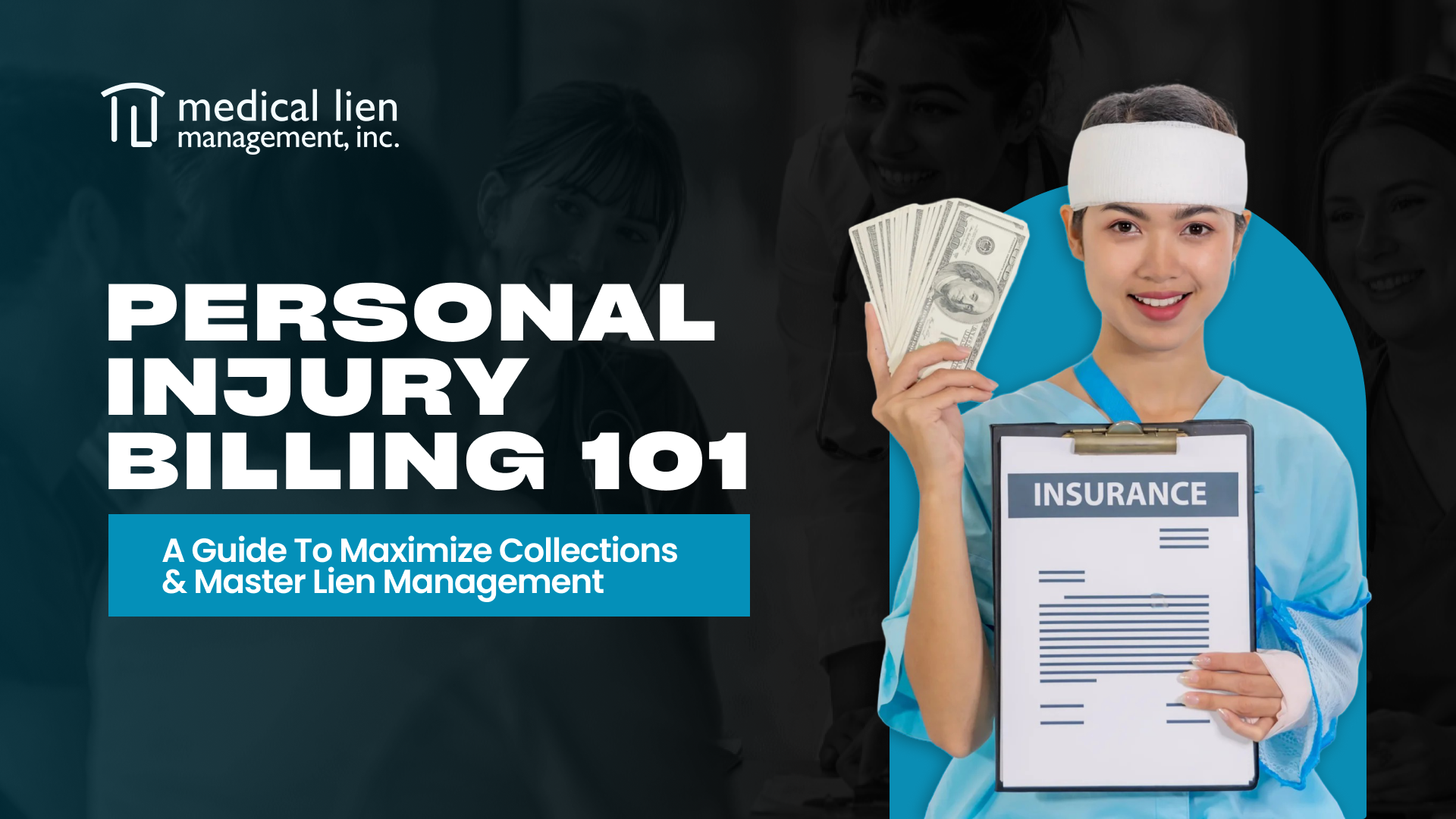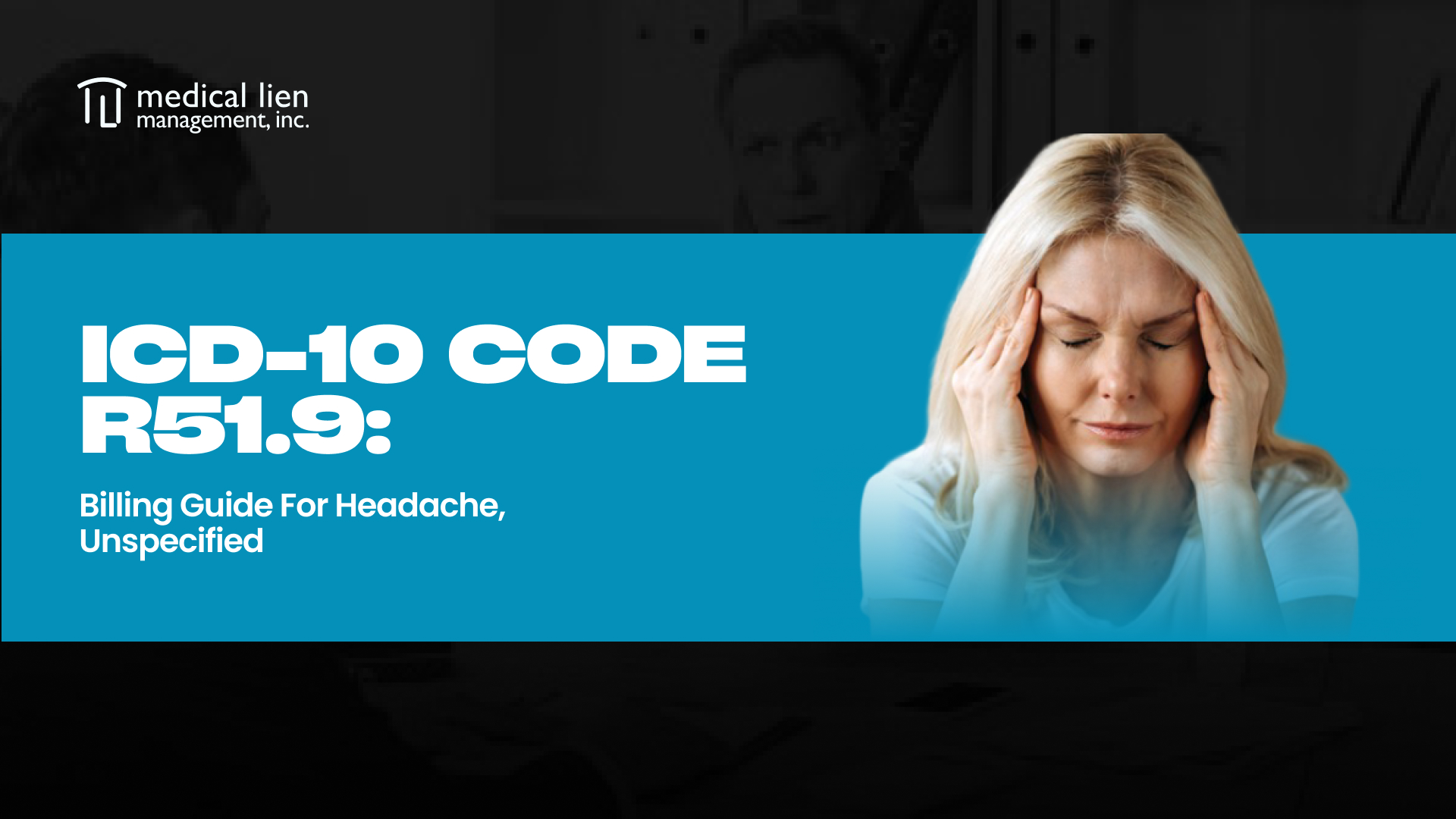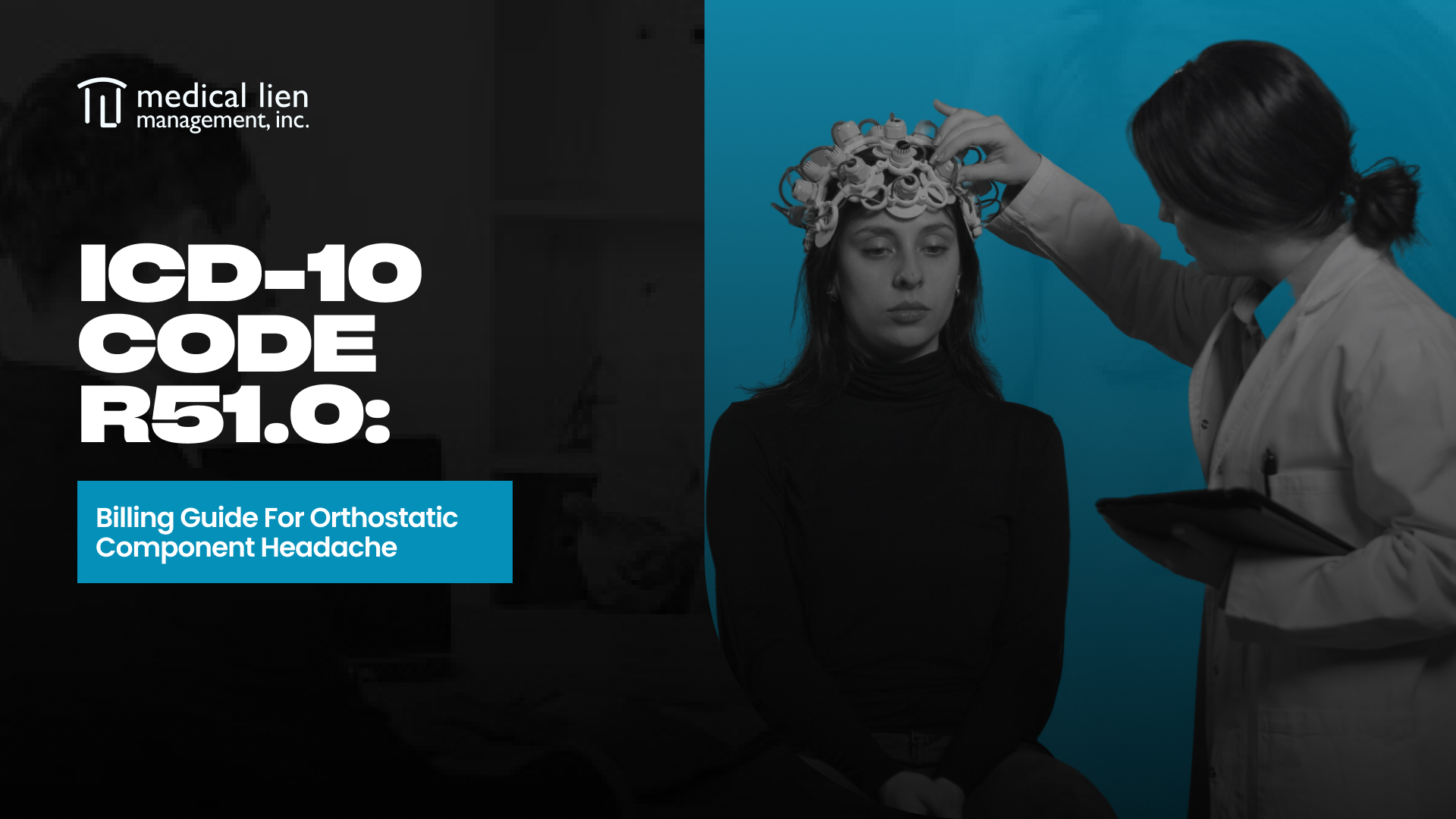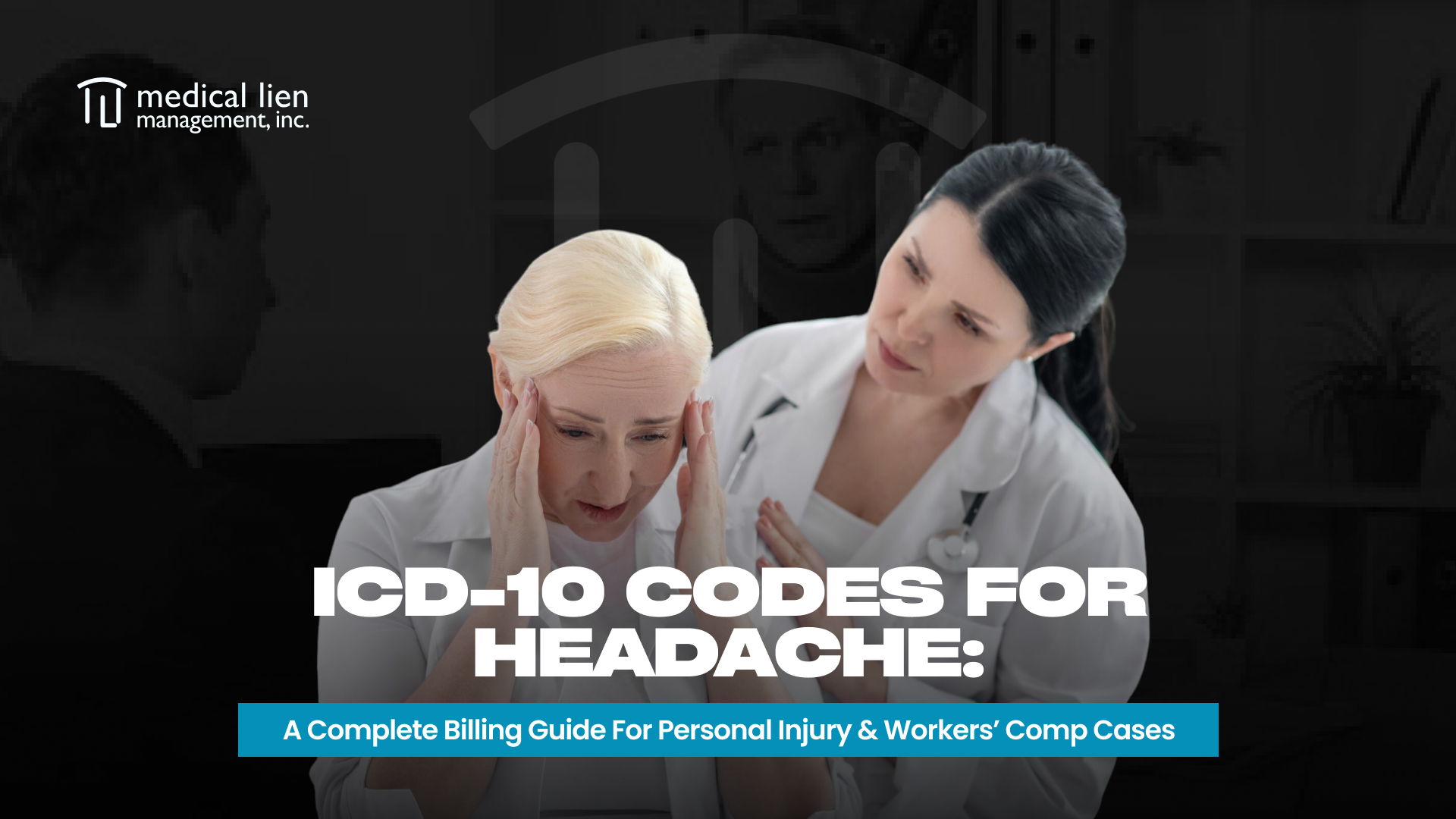If you’re a medical provider treating personal injury (PI) patients, you already know the billing process is complex, slow, and frustrating. Reimbursement is anything but guaranteed, and without the right documentation, coding, and follow-up, you could be leaving thousands on the table.
We get it, and we’re here to help.
This guide will walk you through everything you need to know about personal injury billing and lien management. You’ll learn how it differs from traditional billing, understand the full PI revenue cycle, explore essential coding practices, and uncover the most common challenges (and how to solve them). Whether you’re new to PI or looking to optimize your current workflow, this is your go-to resource.
What is Personal Injury Billing?
Personal injury billing is the process of securing reimbursement for medical services provided to patients who were injured due to accidents, negligence, or other third-party causes. Unlike standard insurance billing, it relies heavily on lien agreements and legal settlements rather than direct health plan payments. This makes the process more complex, lengthier, and dependent on attorneys, insurers, and settlement negotiations.
What are Personal Injury Liens?
A personal injury lien is a legal claim a healthcare provider places on a patient’s future settlement to ensure payment for medical services. Instead of billing the patient or their health insurance, the provider files a lien tied to the personal injury case. Once the case resolves, the lien ensures the provider is compensated directly from the settlement proceeds. Proper lien management is essential to avoid delays, underpayments, or denials.
Why Personal Injury Billing is Different (And Harder)
Unlike standard insurance billing, personal injury billing follows a lien-based model. This makes the process longer, riskier, and more documentation-heavy. If you don’t understand the key differences, you risk delayed, or worse, denied, payments.
Here’s what makes personal injury billing more complex:
- Delayed Payments: Payments are tied to third-party settlements, which can take months, or even years.
- Lien-Based Model: You’re not billing the patient’s health insurance. You’re placing a lien on the settlement.
- Attorney Involvement: Legal teams are often involved, and communication with attorneys is essential for lien negotiation.
- Higher Risk of Denial: Incomplete or inaccurate documentation can lead to denial by insurance adjusters or legal disputes.
- Coding Is Critical: Your codes justify treatment and establish the medical necessity that supports the value of the claim.
These factors increase the administrative burden on providers and highlight the need for a specialized, strategic approach.
The PI Revenue Cycle: From Patient Intake to Lien Recovery
Understanding the full PI revenue cycle helps medical providers stay organized, optimize collections, and ensure no part of the process falls through the cracks. Below is a step-by-step overview of how the PI billing cycle works.
1. Patient Intake and Accident Documentation
It all starts with intake. Collect as much detail as possible about the accident: how it happened, where it occurred, and any legal representation involved. Ask for:
- Police/accident reports
- Attorney contact details
- Auto insurance information
- Pictures (if available)
This information lays the foundation for proper coding and lien filing.
2. Verify Attorney Representation and Insurance Details
Ensure that the patient has an attorney handling the claim and verify the insurance carrier or third-party responsible. Get signed lien agreements between your clinic and the law firm to secure payment later.
3. Accurate ICD-10 and CPT Coding
Correct coding is critical. PI billing requires injury-specific ICD-10 codes, external cause codes, and place of occurrence codes, all of which support the treatment provided and its link to the accident. We’ll break these down later in this guide.
4. Submit the Bill to the Attorney or Third Party
Once coded, the bill is submitted to the attorney or insurance carrier. This is not the same as submitting to a health plan, there are no portals or automatic payments. Clear documentation and justification are required.
5. Track the Case and Communicate
Keep in regular contact with the attorney to track case status. Document all communications and updates. Delays are common, and active follow-up is essential for timely recovery.
6. Negotiate the Lien
Once the case settles, the negotiation begins. Expect pushback from attorneys trying to reduce medical bills. Having accurate documentation, codes, and detailed treatment notes helps you stand your ground.
7. Lien Payment and Final Reconciliation
Once agreed, the payment is processed. Review it carefully to ensure full lien satisfaction and apply payments to patient accounts. Any shortfalls should be documented and, where possible, appealed or re-negotiated.
Why Accurate Coding is Essential for Personal Injury Cases
In personal injury billing, accurate coding isn’t just about compliance, it’s about payment. The right ICD-10 and CPT codes:
- Link the injury to the incident
- Justify the treatment provided
- Establish the value of the medical claim
- Support legal settlement negotiations
- Reduce risk of denial or lien reduction
A single missing external cause code or vague diagnosis can lead to disputes, delays, or even full denial.
Top ICD-10 Codes for Common Personal Injury Scenarios
Here are some of the most used ICD-10 codes in personal injury cases:
- S16.1XXA: Strain of muscle, fascia, and tendon at neck level (Initial encounter)
- S33.5XXA: Sprain of ligaments of lumbar spine (Initial encounter)
- S13.4XXA: Sprain of cervical spine (Initial encounter)
- S43.401A: Sprain of unspecified shoulder joint (Initial encounter)
- S93.401A: Sprain of unspecified ligament of right ankle (Initial encounter)
- S06.0X0A: Concussion without loss of consciousness (Initial encounter)
- S09.90XA: Unspecified injury of head (Initial encounter)
- S39.012A: Strain of muscle, fascia and tendon of lower back (Initial encounter)
External Cause and Place of Occurrence Codes
What are External Cause Codes?
External cause codes (V00–Y99) describe the mechanism of the injury, how it happened. They’re vital in PI billing because they establish a clear link between the injury and the external event.
Common External Cause Codes:
- V43.52XA: Car driver injured in collision with SUV (Initial encounter)
- W01.0XXA: Fall on same level from slipping, tripping and stumbling (Initial encounter)
- X92.XXXA: Assault by drowning and submersion (Initial encounter)
- Y04.2XXA: Assault by strike against or bumped into by another person
- V99.XXXA: Other transport accidents (Initial encounter)
What are Place of Occurrence Codes?
Place of occurrence codes (Y92 series) identify where the injury happened. They add context and support the legitimacy of the claim.
Common Place of Occurrence Codes:
- Y92.410: Gymnasium
- Y92.513: Office building
- Y92.310: Shopping mall
- Y92.821: Parking lot
- Y92.198: Construction site
Using these codes properly strengthens your case and helps justify full lien recovery.
CPT Codes That Support Your PI Cases
Current Procedural Terminology (CPT) codes show what treatment was provided. In PI cases, they validate the necessity and scope of care.
Common CPT Codes for PI Billing:
- 99203–99205: New patient office visits (varies by complexity)
- 97110: Therapeutic exercises
- 97035: Ultrasound therapy
- 97140: Manual therapy techniques
- 20552: Trigger point injections (single muscle group)
- 95851: Range of motion measurements
- 72040: Cervical spine X-ray
- 72100: Lumbar spine X-ray
Each code should match the documentation and reflect medical necessity tied to the injury.
Common Challenges in PI Billing and Lien Collections
Personal injury billing comes with unique administrative and financial hurdles. Each case involves multiple stakeholders, patients, attorneys, insurance adjusters, which complicates everything from documentation to reimbursement. Below are the most common challenges providers face:
1. Delayed or Denied Payments
Unlike traditional health insurance, payments in PI cases are tied to legal settlements. That means you may wait months, or even years, to receive payment. Even after a settlement, insurance adjusters may question the necessity or reasonableness of the charges, leading to delays or denials.
2. Incomplete or Inaccurate Documentation
Missing medical records, incomplete progress notes, or vague diagnosis codes can weaken the lien. If documentation doesn’t clearly connect the injury to the accident, expect attorneys or insurance companies to reduce or reject the bill.
3. Coding Errors
Improper use of ICD-10, CPT, or external cause codes can result in underpayment or outright denial. PI billing demands injury-specific, accident-linked coding. Using non-specific or generic codes gives payers an excuse to argue against your charges.
4. Communication Gaps with Attorneys
Without regular updates from the legal team, it’s difficult to track case progress or know when a settlement occurs. Lack of coordination with attorneys can lead to missed opportunities to negotiate or submit final lien amounts on time.
5. Lien Negotiation Pressure
Attorneys may push for deep reductions in your lien amount to maximize the patient’s settlement share. If your lien isn’t defensible, with clear documentation and accurate coding, you’ll be at a disadvantage during negotiations.
6. Administrative Overload
Managing PI billing internally drains time and resources. It involves tracking multiple open cases, chasing attorneys for updates, responding to denials, and renegotiating liens, often with no guaranteed outcome.
Are You Being Underpaid for Personal Injury Claims and Liens?
It’s common for providers to unknowingly accept lower settlements or lose money on liens. Why? Because the PI reimbursement process is built to benefit insurers and attorneys, not you.
Here’s how the process works against providers:
- Insurance adjusters aim to minimize payouts by questioning medical necessity or requesting reductions.
- Attorneys often negotiate aggressively, sometimes placing your payment last in line.
- You, the provider, bear the administrative burden with no timeline certainty.
And unless your documentation, coding, and follow-up are airtight, your lien could be delayed, reduced, or denied.
That’s where Medical Lien Management (MLM) steps in.
How MLM Helps You Maximize Collections
With over 30 years of experience, MLM is California’s leading expert in personal injury billing and lien collections services. Here’s what sets us apart:
- Comprehensive Lien Management: From patient intake to final payment, we handle the entire process.
- Certified Coders & Billers: Our team uses accurate ICD-10 and CPT codes to ensure every service is justified and defensible.
- Proprietary Jet Filing System: Speeds up submission and ensures error-free documentation.
- Litigation Support: We work with legal teams and provide the necessary records and expert support to defend your lien.
- Guaranteed Follow-Up: We track every case, stay in touch with attorneys, and negotiate on your behalf.
- Faster Collections: Our systemized process reduces delays and maximizes recoveries, without burdening your staff.
Whether you’re tired of denials, overwhelmed by admin, or simply want better outcomes, MLM provides the tools and team to protect your bottom line.
Conclusion
Personal injury billing doesn’t have to be frustrating or uncertain. With the right workflow, accurate coding, and experienced partners, you can turn PI cases into reliable revenue streams.
Remember:
- Personal injury billing is more complex than standard claims.
- Coding and documentation are critical to getting paid.
- Attorney coordination and lien negotiation are unavoidable.
- Without strategic support, you risk underpayment or denial.
Partner with our healthcare revenue cycle services for a smarter, faster, and more profitable approach to personal injury lien recovery.
FAQs
What is a personal injury lien?
A personal injury lien is a legal claim that a medical provider places against a patient’s settlement. It allows the provider to receive payment directly from the proceeds of a personal injury case instead of billing the patient or their health insurance.
How long does it take to get paid on a personal injury lien?
Payment timelines vary depending on the length of the legal case. Some may settle in a few months, while others take years. On average, it takes 6–18 months to receive payment. Timely documentation, coding, and follow-up can reduce delays.
Can a personal injury lien be negotiated?
Yes. Attorneys often attempt to negotiate lien amounts to increase the client’s share of the settlement. If your lien is well-documented, coded accurately, and legally supported, you’ll be in a stronger position to defend it.
What happens if a personal injury case doesn’t settle?
If the case doesn’t settle or results in no compensation, the lien may not be paid. That’s why thorough vetting at intake, along with a signed lien agreement, is essential to reduce risk.





